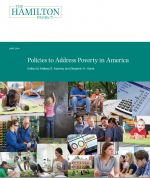
This proposal is chapter ten of The Hamilton Project’s Policies to Address Poverty in America, and a segment in Improving Safety Net and Work Support.
Download the full eBook»
Introduction
Economic self-sufficiency through labor market work for low-income families, especially those headed by a single mother, formed a fundamental tenet of both the 1993 expansion in the Earned Income Tax Credit (EITC) and the 1996 Personal Responsibility and Work Opportunity Reconciliation Act (aka welfare reform). While both reforms have been credited with expanding employment of single mothers in the years immediately following implementation (Grogger 2003; Meyer and Rosenbaum 2001), employment rates of mothers with dependent children have been on a steady decline over the past decade, leaving many families unable to make ends meet (Blank and Kovak 2008; Bollinger, Gonzalez, and Ziliak 2009; Fox et al. 2013).
A key financial challenge facing these families is finding affordable child care. In 2012 the average annual cost for full-day, center-based care of an infant ranged from $4,850 in Mississippi to $16,450 in Massachusetts; for care of a four-year-old, the cross-state range was $4,300 to $12,350 (Child Care Aware of America 2013). As a fraction of average annual earnings among single mothers with children under the age of five, child-care costs amount to over one-fourth of earnings in Mississippi and over one-third of earnings in Massachusetts. Evidence suggests that children do better in model, center-based care than in informal, home-based care on a host of cognitive and noncognitive measures (Bernal and Keane 2011; Blau and Currie 2006; Morris et al. 2009), and that women respond to reductions in effective child-care prices by increasing their participation in the labor force (Baum 2002; Berger and Black 1992; Kimmel 1995; Tekin 2007).
This policy memo introduces a way to restructure an existing federal child-care tax credit to better incentivize work and improve the financial and child well-being for low-income families. Specifically, I propose converting the Child and Dependent Care Credit (CDCC) from a nonrefundable credit—a credit that cannot exceed the income taxes owed by a family—to a refundable credit—one that can result in a net gain after taxes—that is targeted to low- and middle-income families. Because current law does not limit eligibility for the CDCC based on income, the majority of tax expenditures are spent on those families with annual incomes between $100,000 and $200,000 (Maag 2013). I propose capping eligibility at $70,000 and making the credit a progressive function of income, the age of the child (ages zero to four versus five to twelve), and utilization of certified, licensed care facilities. These reforms, to be implemented at the federal level, will make labor market work more attractive to low-income families by providing much-needed financial relief from the high cost of child care. In addition, by reducing the out-of-pocket cost of care for low-income workers, the reformed credit will enable more families to place children in formal instead of informal care settings.



